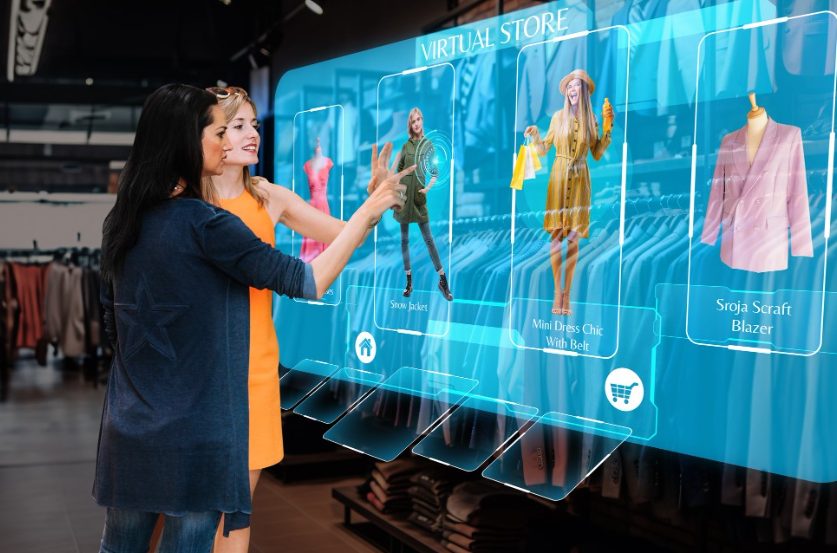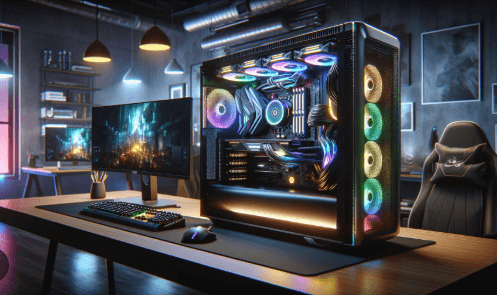Introduction: The Intersection of Augmented Reality and Retail
In recent years, Augmented Reality (AR) has become a buzzword in the world of technology and innovation, making waves in various industries. Among the sectors most affected is retail and e-commerce. AR is reshaping the way consumers engage with products, offering immersive experiences that blend the digital and physical worlds. From virtual try-ons to 3D product previews, the possibilities seem endless. This article explores how augmented reality is revolutionizing the retail and e-commerce landscapes and what it means for businesses and consumers alike.
Understanding Augmented Reality (AR) Technology
What is Augmented Reality?
Augmented Reality (AR) is a technology that overlays digital information—such as images, sounds, or other sensory stimuli—onto the real world, enhancing the way we perceive our surroundings. Unlike Virtual Reality (VR), which immerses users in a completely digital environment, AR integrates digital elements into the real world, creating a more interactive and engaging experience.
The Technology Behind AR: Key Components
The backbone of AR technology includes a combination of hardware and software that work together to create the experience. Key components include:
- Hardware: Devices such as smartphones, AR glasses, and smart lenses that display the augmented content.
- Software: AR applications that process and render digital content to fit seamlessly within the real-world environment.
- Sensors and Cameras: These capture real-time data to understand the user’s surroundings and adjust the AR content accordingly.
- Displays: Screens or lenses that display the AR content to the user.
With the rapid advancement of AR technology, these components have become more affordable and accessible, enabling retailers to incorporate AR into their business models.
See also: seventhway
The Impact of AR on the Retail Industry
Transforming the In-Store Experience
AR is changing the way customers interact with physical stores. In the past, the shopping experience was largely confined to what could be seen on shelves. Today, AR allows customers to visualize additional information, product features, and even virtual demonstrations right in front of them. For example, customers can point their smartphones at a product and see detailed specifications, reviews, or usage tutorials in real time.
Retailers are leveraging AR to enhance the in-store shopping experience by:
- Virtual product demos: Allowing customers to see how products work or are used.
- Interactive product displays: Customers can interact with AR displays to visualize how a product fits into their daily lives.
Enhancing the Online Shopping Journey
For online shoppers, AR technology provides a bridge between the digital and physical worlds. AR allows consumers to virtually “try on” clothes, accessories, or even makeup before making a purchase. Online furniture retailers, for example, use AR to help customers see how a sofa would look in their living room before they buy it. This level of interactivity and visualization has been proven to reduce hesitation and increase purchase confidence.
The Role of AR in E-Commerce
Virtual Try-Ons and Product Previews
One of the most significant breakthroughs AR offers to e-commerce is the ability for customers to virtually try products before purchasing. Popular examples include:
- Fashion Retail: Virtual fitting rooms that allow customers to see how clothes, shoes, or accessories would look on them.
- Beauty Industry: Virtual makeup try-ons, where consumers can apply different cosmetic products to their faces using AR filters.
- Eyewear: AR apps that let consumers virtually try on glasses to see how different styles and frames look on their faces.
3D Product Displays: Making Online Shopping Real
Another major impact of AR on e-commerce is the use of 3D models. Instead of relying on static images, retailers can offer interactive 3D models of products that allow customers to rotate, zoom, and view items from all angles. This allows for a more accurate representation of the product, reducing uncertainty and minimizing the likelihood of returns.
Personalization in Retail: AR as a Game-Changer
Tailoring Shopping Experiences with AR
AR has taken personalization to the next level. By leveraging customer data, AR can offer tailored shopping experiences based on individual preferences. For example, an AR app can show customized product recommendations, suggest outfits, or even provide personalized promotions based on the user’s browsing behavior or past purchases.
How AR Helps with Product Discovery
AR also aids in product discovery by offering dynamic, context-aware recommendations. In physical stores, customers can use AR apps to scan barcodes or product labels to instantly receive additional information, such as complementary products or alternatives that suit their preferences. This helps customers discover new products they might not have come across otherwise.
How AR Boosts Consumer Engagement and Loyalty
Gamification of the Shopping Experience
AR has a unique ability to gamify the shopping experience, which is particularly appealing to younger consumers. By integrating interactive elements such as rewards, challenges, and virtual collections, brands can keep customers engaged longer and encourage repeat visits. For instance, AR-powered scavenger hunts, where consumers use their smartphones to find virtual objects hidden in the store, can make the shopping process more enjoyable.
Interactive and Immersive Advertising
AR takes advertising to a whole new level by offering immersive and interactive ads. Rather than passively watching ads, consumers can interact with them, leading to deeper engagement. For example, a cosmetics brand could use AR to allow customers to interact with a virtual beauty consultant or test out products in real-time.
AR and Retail Innovation: The Future of Shopping
The Rise of Smart Stores and AR Integration
Smart stores are becoming a reality, where AR is seamlessly integrated into the store’s infrastructure. For example, smart mirrors can allow customers to try on clothing virtually or adjust lighting to see how an outfit looks under different conditions. These innovations will create an entirely new shopping environment that blends digital experiences with physical stores.
Predicting the Future of AR in Retail
In the coming years, we can expect to see even more sophisticated AR experiences. With advancements in AI, AR will become more personalized and intuitive, able to respond to user needs in real-time. Retailers will continue to experiment with AR as a way to engage customers, enhance their shopping experiences, and drive sales.
The Benefits of AR for Retailers and E-Commerce Brands
Increased Conversion Rates and Sales
AR has been shown to increase conversion rates and boost sales. By giving customers a more immersive and interactive shopping experience, retailers can reduce hesitation and encourage immediate purchases. Additionally, the ability to try before you buy and visualize products in real time increases consumer confidence, leading to higher purchase rates.
Cost Efficiency and Reduced Return Rates
Another major benefit of AR for retailers is the reduction in return rates. When customers can visualize a product in their environment or try it on virtually, they are more likely to be satisfied with their purchase. This can lead to fewer returns, reducing the costs associated with logistics, restocking, and lost sales.
Challenges Facing AR in Retail and E-Commerce
Technological Limitations and Integration Issues
Despite its many advantages, AR technology is not without challenges. The initial cost of developing AR apps and integrating them into existing retail systems can be prohibitive for some businesses. Additionally, the quality of the AR experience can vary, leading to inconsistencies in user experience.
Consumer Adoption Barriers
While younger consumers are quick to adopt new technologies, older generations may be less familiar with AR, creating a barrier to widespread adoption. To overcome this, retailers will need to invest in education and create user-friendly experiences that appeal to all demographics.
The Role of AR in Omnichannel Retailing
Connecting Physical and Digital Retail Experiences
AR plays a critical role in omnichannel retailing by seamlessly connecting physical stores with digital experiences. By incorporating AR in both physical stores and online platforms, retailers can create a unified and consistent shopping experience that meets the expectations of today’s tech-savvy consumers.
AR’s Role in Bridging the Gap in Consumer Expectations
As consumers increasingly expect personalized, immersive, and efficient shopping experiences, AR can bridge the gap between their expectations and reality. Whether shopping online or in a brick-and-mortar store, AR offers a new way to engage with products and brands in a meaningful way.
Case Studies: Successful AR Implementation in Retail
IKEA’s AR Shopping Experience
IKEA has been a pioneer in using AR technology to enhance the shopping experience. Their “IKEA Place” app allows customers to place virtual furniture in their homes using AR, helping them visualize how pieces will fit and look in their space before making a purchase. This has led to increased consumer confidence and sales.
Sephora’s Virtual Artist App
Sephora has embraced AR with their “Virtual Artist” app, allowing users to try on makeup virtually. This has revolutionized the beauty industry by giving customers the opportunity to experiment with products from the comfort of their homes, leading to increased engagement and sales.
The Future of Augmented Reality in Retail and E-Commerce
Predictions for 2025 and Beyond
As AR technology continues to evolve, we can expect more innovations in retail and e-commerce. With the introduction of AR glasses and wearable devices, the shopping experience will become even more immersive and accessible. Additionally, advancements in AI and machine learning will make AR experiences even more personalized and intuitive.
Emerging Trends to Watch Out For
In the coming years, look out for trends such as AR-powered smart shopping carts, interactive in-store experiences, and advanced AR-driven customer service solutions that further enhance the shopping experience.
Conclusion: Embracing AR for a New Era of Shopping
Augmented Reality is transforming the retail and e-commerce industries in profound ways, enabling businesses to create immersive and personalized shopping experiences. From virtual try-ons and product previews to gamified shopping experiences, AR offers immense potential for both retailers and consumers. As the technology continues to evolve, the future of retail looks brighter than ever.
FAQs
- What is Augmented Reality in retail?
Augmented Reality (AR) in retail allows customers to interact with products digitally by overlaying virtual objects onto the real world, enhancing the shopping experience. - How does AR benefit e-commerce?
AR in e-commerce helps customers visualize products in their environment, try products virtually, and experience a more interactive shopping journey. - Is AR expensive for retailers to implement?
While the initial investment in AR technology can be high, the long-term benefits—such as increased sales and reduced return rates—often outweigh the costs. - Can AR increase conversion rates?
Yes, AR has been shown to boost conversion rates by allowing consumers to visualize products more accurately and make confident purchasing decisions. - What are some successful examples of AR in retail?
IKEA’s AR app and Sephora’s Virtual Artist app are great examples of how AR enhances the shopping experience. - What does the future hold for AR in retail?
The future of AR in retail includes more immersive shopping experiences, integration with wearable devices, and enhanced personalization through AI.




